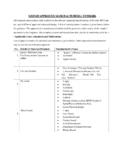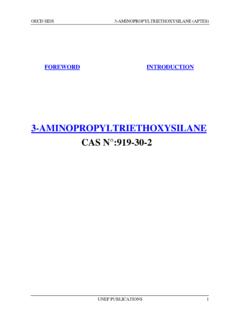Transcription of Improved Thermal Management, Reliability and Cost ...
1 Advanced Silicone Materials for electric vehicle ElectronicsIMAGINEI mproved Thermal management , Reliability and cost - effectiveness for electric vehicle Electronics IMAGINED esigns for the Future .. TodayThe market for plug-in hybrid and battery-powered electric vehicles (xEV) has the potential to grow exponentially in the coming years. But realizing that potential will depend on a number of factors, including the industry s ability to meet consumer expectations for performance and value. This will challenge battery makers to design for the large-volume production of lithium battery packs that are smaller, lighter and less expensive. These higher-energy-density packs will be capable of delivering more power, longer, through better Thermal and designers of other xEV components including battery management systems, power control units, DC/DC converters and electric motors face many of the same Thermal management , assembly and protection Corning can help, with an extensive portfolio of proven.
2 Innovative and emerging silicone technologies for xEV Compressor for Air ConditionerAC/DC ChargerSILICONE ADVANTAGESThe properties that have enabled silicone materials from Dow Corning to excel in a wide range of electronics and automotive applications could prove invaluable in helping you address challenges associated with designing and producing large volumes of lithium battery systems and other components for the electric vehicles of tomorrow: Very low Thermal resistance Flow, wetting, adhesion and cure properties that can help speed and simplify processing Excellent Thermal stability wide operating temperature range Reliable performance under harsh conditions resistance to Thermal shock, oxidation, moisture and chemicals Excellent electrical insulation (dielectric strength) Excellent stress relief3DC/DC ConverterSheath HeaterPTC HeaterBattery management System (BMS)
3 Battery ModuleSILICONE ADVANTAGESThe properties that have enabled silicone materials from Dow Corning to excel in a wide range of electronics and automotive applications could prove invaluable in helping FOR Thermal management Thermally conductive silicone materials from Dow Corning have properties that can help you reduce operating temperatures and extend the life and performance of batteries and other electric vehicle electronic Corning offers a wide range of Thermal interface materials with the potential for creating effective, efficient designs and assembly applications. Examples of leading technologies include: Thermally conductive silicone adhesives for coupling the battery pack to the heat sink; also may be appropriate for use within or between cells Noncuring thermally conductive silicone compounds, with a possible applied temperature range of -40 to 150 C, for conducting heat from the battery cells to the heat sink Thermally conductive silicone gels and encapsulants are flowable materials that facilitate high-volume processes in automated production; can be used as an alternative to precured pads to couple cells and modules to heat sinks or as conformable gap-fillersFOR OTHER CHALLENGESDow Corning offers proven and innovative materials to help you meet a wide range of electric vehicle application challenges.
4 Silicone gels for potting of electronics in the battery pack s power management system Adhesives for a variety of bonding applications, including staking large capacitors for vibration control, extra support for large components on circuit boards, and housing sealing Conformal coatings for protecting electronic circuit boards in the power management system Engineered elastomers for heat-resistant sealing and gasketingSilicone Materials Problem-Solving Enabling &Silicone is an amazingly versatile material that can be produced in many forms. Dow Corning is a silicone pioneer and a global leader in engineering silicones to meet specific performance and processing Enabling &Problem-Solving Enabling &Problem-Solving To meet needs for performance, design flexibility and cost control5 Dow Corning EA-7100 AdhesiveA Thermal Radical Cure adhesive for use in the assembly of electronics housings and for attaching connectors, electronic control units or sensors to substratesDow Corning EA-7100 Adhesive cures much faster at moderate temperatures than conventional heat-curable silicones, and it may allow you to eliminate some cleaning steps, enabling faster throughput and lower energy costs.
5 Plus, it offers durable adhesion to a broad range of diverse substrates for greater design flexibility. Other quality- and performance-enhancing benefits include adhesion in harsh environments, low void formation, superior anti-corrosion performance and less sensitivity to Corning TC-4525 Thermally Conductive Gap FillerA cost -effective way to manage the rising heat in next-generation electronics designsDow Corning TC-4525 Thermally Conductive Gap Filler is a soft and compressible silicone material designed to dissipate heat from electronic devices. This high-performing new silicone technology delivers Thermal conductivity of , greatly Improved dispensability and stable performance for more reliable electronics in harsh automotive underhood UV lightBREAKTHROUGHP roduct1 or 2 PartColorThermal Conductivity, Resistance, C/WLap ShearCure, , cPDensity, g/cm3 DurometerCTE, ppm/KNotesThermally Conductive Gap FillersDow Corning TC-4515 Thermally Conductive Gap Filler In development: silicone gap filler material for automotive electronics In development: silicone gap filler material for automotive electronicsDow Corning TC-4525 Thermally Conductive Gap Filler2 part (1:1 mix ratio)Part A: White Part B: @ 85 m @ 115 @ 309 m -120 min/25 C20 min/50 C10 min/80 CPart A: 207,000 Part B.
6 193,000 Mixed: 217, (Shore 00)-50 to 80 C: 95-50 to 150 C: 123 -Dow Corning TC-4525 GB Thermally Conductive Gap FillerGlass bead option (180 micron) for Dow Corning TC-4525 Thermally Conductive Gap FillerGlass bead option (180 micron) for Dow Corning TC-4525 Thermally Conductive Gap FillerDow Corning TC-4525 CV Thermally Conductive Gap Filler2 part (1:1 mix ratio)Part A: WhitePart B: - -120 min/25 C10 min/80 CPart A: 223,000 Part B: 216,000 Mixed: 217,000 Cured: (Shore 00) 32 (Asker C)--Dow Corning TC-4529 Thermally Conductive Gap Filler1 @ 78 @ 100 @ 400 m -Noncuring300, - - -Dow Corning TC-4530 Thermally Conductive Gap Filler In developmentIn developmentThermally Conductive AdhesivesDow Corning TC-2030 Thermally Conductive Adhesive2 part(1:1 mix ratio) -Al: 435 psi, 3 MPa, 300 N/cm260 min/130 CPart A: 250,000 Part B: 200,000 Mixed: 220,000 -92 (Shore A) - -Dow Corning TC-2035 Thermally Conductive Adhesive2 part(1:1 mix ratio)Part A: WhitePart B: Reddish @ 50 @ 100 mAl: 381 psi, MPa, 263 N/cm2Cu: 416 psi, MPa, 287 N/cm230 min/125 C10 min/150 CPart A: 130,000 Part B: 118,000 Mixed: 125,000 Wet: 395 (Shore A [JIS Type A])45 (Shore D)-50 to 200 C: 92 -Dow Corning SE 4485 Thermally Conductive Adhesive1 -Glass to glass: 168 psi, MPa, 120 N/cm2 Tack-free time(1) @ 25 C: 10 minFluidity: 54 mmCured: (Shore A [JIS]) -UL 94 V-0 Dow Corning SE 4485 L Thermally Conductive Adhesive1 -Glass to glass: 262 psi, MPa, 180 N/cm2 Tack-free time(1) @ 25 C: 8 minFluidity: mmCured.
7 (Shore A [JIS]) - -Dow Corning SE 4486 Thermally Conductive Adhesive1 -Glass to glass: 240 psi, MPa, 165 N/cm2 Tack-free time(1) @ 25 C: 4 min19,600 Fluidity: 60 mmCured: (Shore A [JIS]) - -Thermally Conductive EncapsulantsDow Corning TC-4605 Thermally Conductive Encapsulant2 part (1:1 mix ratio)Gray1 -Al: 110 psi60 min/120 CPart A: 3,100 Part B: 2,500 Mixed: 2,900 Cured: (Shore A) -UL flammability @ mm: 94 V-0 Dow Corning TC-4605 HLV Thermally Conductive Encapsulant2 part (1:1 mix ratio)Gray1 -Anodized Al: 220 psi60 min/120 CPart A: 1,600 Part B: 1,400 Mixed: 1,900 Cured: (Shore A) -UL flammability @ mm: 94 V-0(1)Tack-free time is the time required for the product to develop a nontacky surface based on adhesion to a polyethylene or 2 PartColorViscosity, cPDensity, g/cm3 Cure, ShearDurometerTensile Strength, MPaElongation, % NotesAdhesivesDow Corning EA-5151 QiC Adhesive(1) 1 part -60,000 @ 120 Room temperature cure when exposed to moisture in the airPolycarbonate lap shear adhesion:1 day: MPa7 days: MPa55-57 (Shore A) >900 Can be used with standard hot-melt dispensing equipmentDow Corning 7091 Adhesive/Sealant(2)1 partBlack, white, gray temperature cure when exposed to moisture in the air; tack-free time(3): 28 min-32 (Shore A) (2)Dow Corning SE 9168 RTV Adhesive1 partGray -Cured: temperature cure when exposed to moisture in the air.
8 Tack-free time(3) @ 25 C: minGlass: 275 psi, MPa, 189 N/cm244 (Shore A [JIS]) 94 V-0 Dow Corning SE 9185 Clear or White Adhesive1 partClear or white -Cured: temperature cure when exposed to moisture in the air; tack-free time(3) @ 25 C: 8 minGlass: 120 N/cm231 (Shore A)3515 -Dow Corning EA-1236 Base and Catalyst Special Black Adhesive 2 part; (base-to-catalyst mix ratio by weight: 100 to 14)Base: WhiteCatalyst: Black180,000 @ s-1160,000 @ 5 s-1 Base: : : temperature cure;tack-free time(3): 10 min -36 (Shore A)(4) room-temperature cureSilicone FoamDow Corning 3-8209 Silicone Foam(5)2 part (1:1 mix ratio)Part A: Dark grayPart B: ColorlessPart A: 11,000-17,000 Part B: 12,000-17,000 Part A: B: : 200-280(cured @ 23 C and tested after 24 hr)Room temperature cure when exposed to moisture in the air; tack-free time(3) @ 25 C: max 10 min -45 (Shore 00) - -Compression set @ 50% compression, 22 hr @ 70 C: Non-post-cured: 32% Post-cured 1 hr @ 100 C: 4% Stress-strain characteristics in compression, 50% compression: 74 KPa(1)Developmental product data.
9 QiC : quick-in-connect adhesive. Utilizes silicone technology to achieve instant green strength when dispensed and cures to a strong moisture-cured silicone adhesive.(2)Used as formed-in-place gasket (FIPG) material. Mechanical properties: cured 7 days in air at 23 C (73 F) and 50% relative humidity. (3)Tack-free time is the time required for the product to develop a nontacky surface based on adhesion to a polyethylene film.(4)Measured after 7-day cure at room temperature. (5)Designed to be dispensed and cured directly on parts to form an integrated compression gasket. Thermal MANAGEMENTASSEMBLYxEV Battery Pack BATTERY6 Product1 or 2 PartColorThermal Conductivity, Resistance, C/WLap ShearCure, , cPDensity, g/cm3 DurometerCTE, ppm/KNotesThermally Conductive Gap FillersDow Corning TC-4515 Thermally Conductive Gap Filler In development: silicone gap filler material for automotive electronics In development: silicone gap filler material for automotive electronicsDow Corning TC-4525 Thermally Conductive Gap Filler2 part (1:1 mix ratio)Part A: White Part B: @ 85 m @ 115 @ 309 m -120 min/25 C20 min/50 C10 min/80 CPart A: 207,000 Part B: 193,000 Mixed: 217, (Shore 00)-50 to 80 C: 95-50 to 150 C.
10 123 -Dow Corning TC-4525 GB Thermally Conductive Gap FillerGlass bead option (180 micron) for Dow Corning TC-4525 Thermally Conductive Gap FillerGlass bead option (180 micron) for Dow Corning TC-4525 Thermally Conductive Gap FillerDow Corning TC-4525 CV Thermally Conductive Gap Filler2 part (1:1 mix ratio)Part A: WhitePart B: - -120 min/25 C10 min/80 CPart A: 223,000 Part B: 216,000 Mixed: 217,000 Cured: (Shore 00) 32 (Asker C)--Dow Corning TC-4529 Thermally Conductive Gap Filler1 @ 78 @ 100 @ 400 m -Noncuring300, - - -Dow Corning TC-4530 Thermally Conductive Gap Filler In developmentIn developm


